Nursing Assignment: Global Strategies and Singapore's Adaptation
VerifiedAdded on 2023/06/10
|21
|5946
|358
Essay
AI Summary
This nursing assignment delves into the critical issue of an aging population, particularly in developed countries like Singapore, which boasts a commendable healthcare system. The essay examines global theoretical and legislative perspectives on positive nursing care for older people, with a focus on dementia. It includes a case study of a 64-year-old patient, Mr. Patrick, diagnosed with vascular dementia and osteoarthritis, and discusses his memory issues, disturbed thought processes, and other related challenges. The assignment analyzes theories of aging, including programmed and damage/error theories, and their relevance to dementia. It further explores person-centered nursing care models and the World Health Organization's strategies for supporting elderly healthcare users, including the 'Global action plan on the public health response to dementia 2017-2025,' and how Singapore adapts and implements these strategies. Finally, it develops comprehensive care plans for the patient, addressing disturbed thought processes, chronic confusion, self-care deficits, sleep disturbances, and wandering, to ensure a healthy recovery for elderly healthcare users.
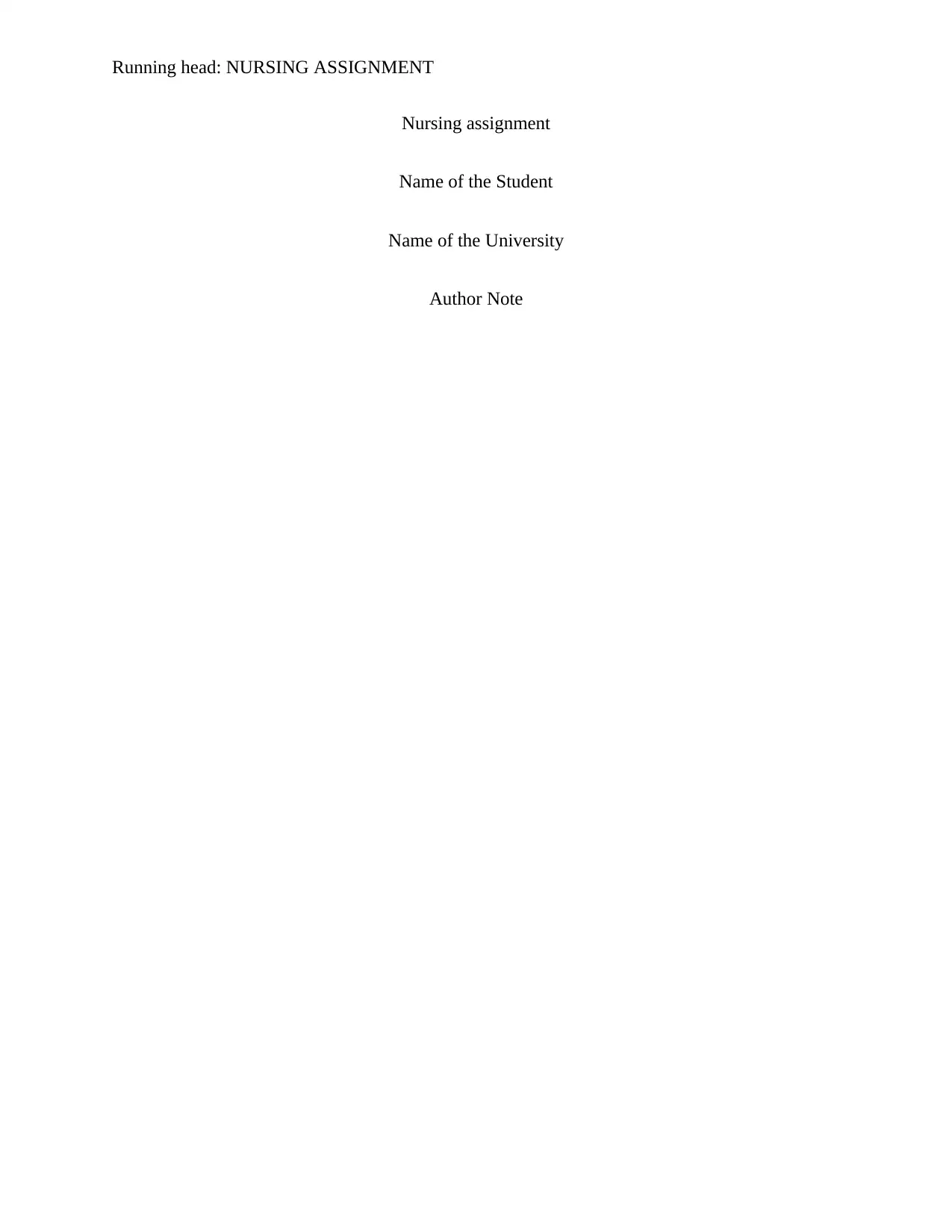
Running head: NURSING ASSIGNMENT
Nursing assignment
Name of the Student
Name of the University
Author Note
Nursing assignment
Name of the Student
Name of the University
Author Note
Paraphrase This Document
Need a fresh take? Get an instant paraphrase of this document with our AI Paraphraser
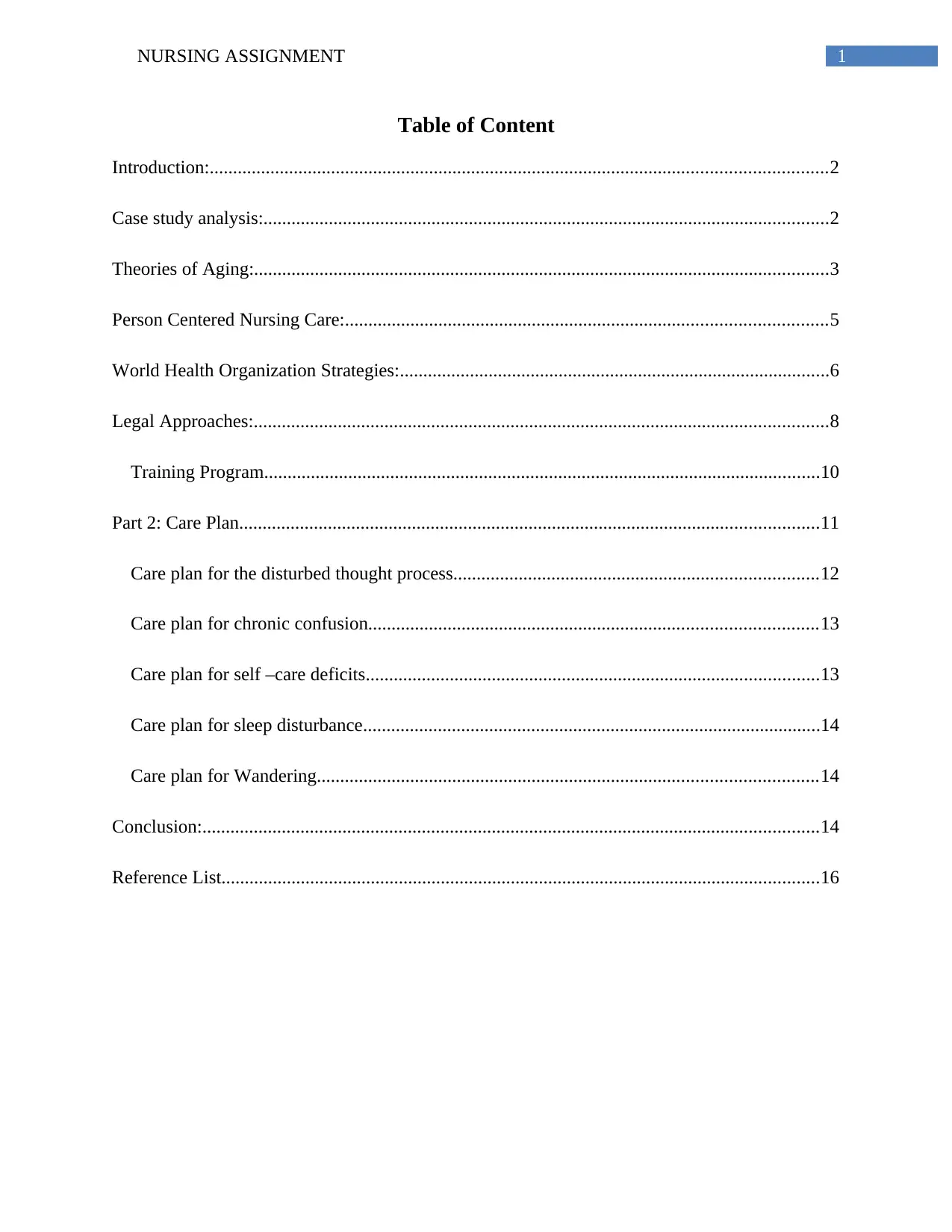
1NURSING ASSIGNMENT
Table of Content
Introduction:....................................................................................................................................2
Case study analysis:.........................................................................................................................2
Theories of Aging:...........................................................................................................................3
Person Centered Nursing Care:.......................................................................................................5
World Health Organization Strategies:............................................................................................6
Legal Approaches:...........................................................................................................................8
Training Program.......................................................................................................................10
Part 2: Care Plan............................................................................................................................11
Care plan for the disturbed thought process..............................................................................12
Care plan for chronic confusion................................................................................................13
Care plan for self –care deficits.................................................................................................13
Care plan for sleep disturbance..................................................................................................14
Care plan for Wandering...........................................................................................................14
Conclusion:....................................................................................................................................14
Reference List................................................................................................................................16
Table of Content
Introduction:....................................................................................................................................2
Case study analysis:.........................................................................................................................2
Theories of Aging:...........................................................................................................................3
Person Centered Nursing Care:.......................................................................................................5
World Health Organization Strategies:............................................................................................6
Legal Approaches:...........................................................................................................................8
Training Program.......................................................................................................................10
Part 2: Care Plan............................................................................................................................11
Care plan for the disturbed thought process..............................................................................12
Care plan for chronic confusion................................................................................................13
Care plan for self –care deficits.................................................................................................13
Care plan for sleep disturbance..................................................................................................14
Care plan for Wandering...........................................................................................................14
Conclusion:....................................................................................................................................14
Reference List................................................................................................................................16
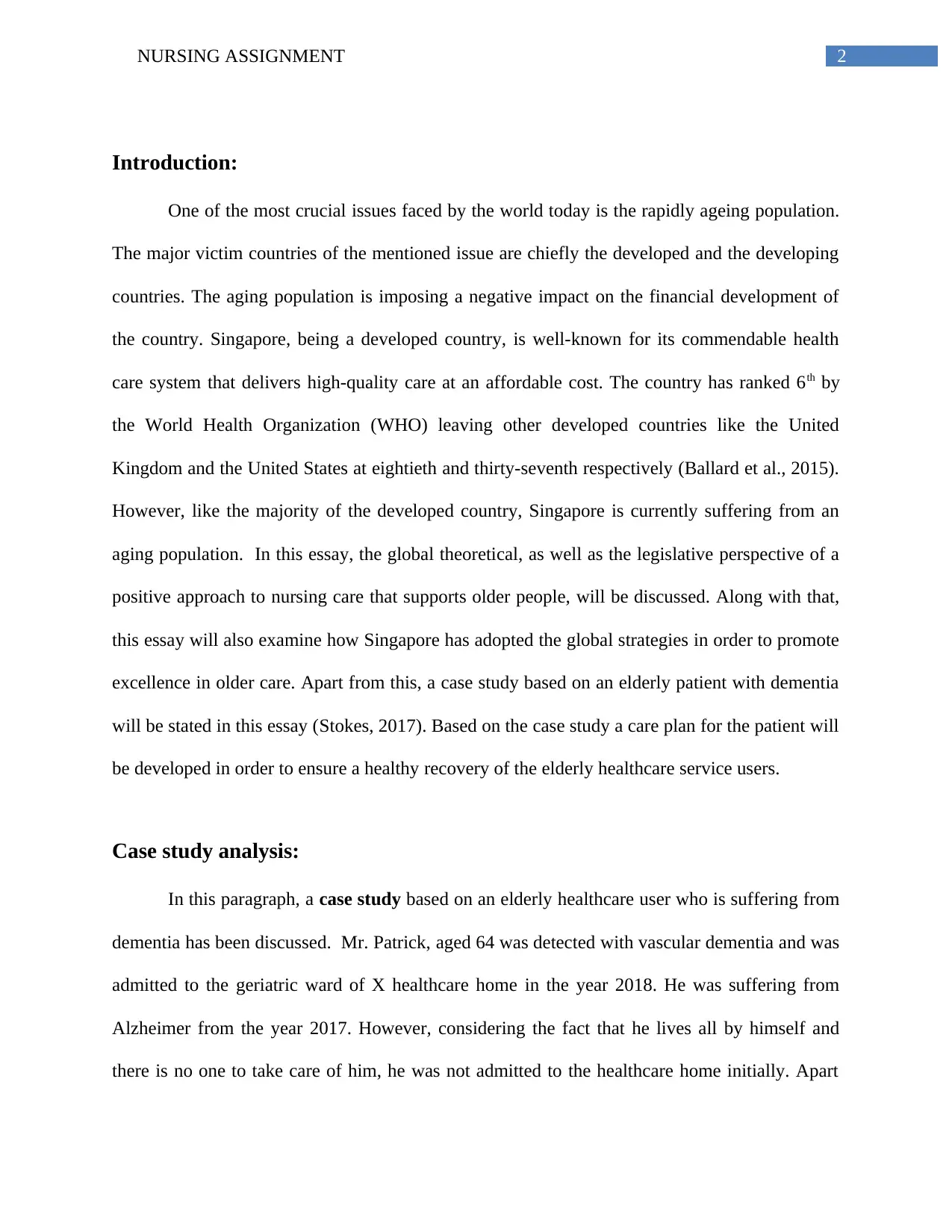
2NURSING ASSIGNMENT
Introduction:
One of the most crucial issues faced by the world today is the rapidly ageing population.
The major victim countries of the mentioned issue are chiefly the developed and the developing
countries. The aging population is imposing a negative impact on the financial development of
the country. Singapore, being a developed country, is well-known for its commendable health
care system that delivers high-quality care at an affordable cost. The country has ranked 6th by
the World Health Organization (WHO) leaving other developed countries like the United
Kingdom and the United States at eightieth and thirty-seventh respectively (Ballard et al., 2015).
However, like the majority of the developed country, Singapore is currently suffering from an
aging population. In this essay, the global theoretical, as well as the legislative perspective of a
positive approach to nursing care that supports older people, will be discussed. Along with that,
this essay will also examine how Singapore has adopted the global strategies in order to promote
excellence in older care. Apart from this, a case study based on an elderly patient with dementia
will be stated in this essay (Stokes, 2017). Based on the case study a care plan for the patient will
be developed in order to ensure a healthy recovery of the elderly healthcare service users.
Case study analysis:
In this paragraph, a case study based on an elderly healthcare user who is suffering from
dementia has been discussed. Mr. Patrick, aged 64 was detected with vascular dementia and was
admitted to the geriatric ward of X healthcare home in the year 2018. He was suffering from
Alzheimer from the year 2017. However, considering the fact that he lives all by himself and
there is no one to take care of him, he was not admitted to the healthcare home initially. Apart
Introduction:
One of the most crucial issues faced by the world today is the rapidly ageing population.
The major victim countries of the mentioned issue are chiefly the developed and the developing
countries. The aging population is imposing a negative impact on the financial development of
the country. Singapore, being a developed country, is well-known for its commendable health
care system that delivers high-quality care at an affordable cost. The country has ranked 6th by
the World Health Organization (WHO) leaving other developed countries like the United
Kingdom and the United States at eightieth and thirty-seventh respectively (Ballard et al., 2015).
However, like the majority of the developed country, Singapore is currently suffering from an
aging population. In this essay, the global theoretical, as well as the legislative perspective of a
positive approach to nursing care that supports older people, will be discussed. Along with that,
this essay will also examine how Singapore has adopted the global strategies in order to promote
excellence in older care. Apart from this, a case study based on an elderly patient with dementia
will be stated in this essay (Stokes, 2017). Based on the case study a care plan for the patient will
be developed in order to ensure a healthy recovery of the elderly healthcare service users.
Case study analysis:
In this paragraph, a case study based on an elderly healthcare user who is suffering from
dementia has been discussed. Mr. Patrick, aged 64 was detected with vascular dementia and was
admitted to the geriatric ward of X healthcare home in the year 2018. He was suffering from
Alzheimer from the year 2017. However, considering the fact that he lives all by himself and
there is no one to take care of him, he was not admitted to the healthcare home initially. Apart
⊘ This is a preview!⊘
Do you want full access?
Subscribe today to unlock all pages.

Trusted by 1+ million students worldwide
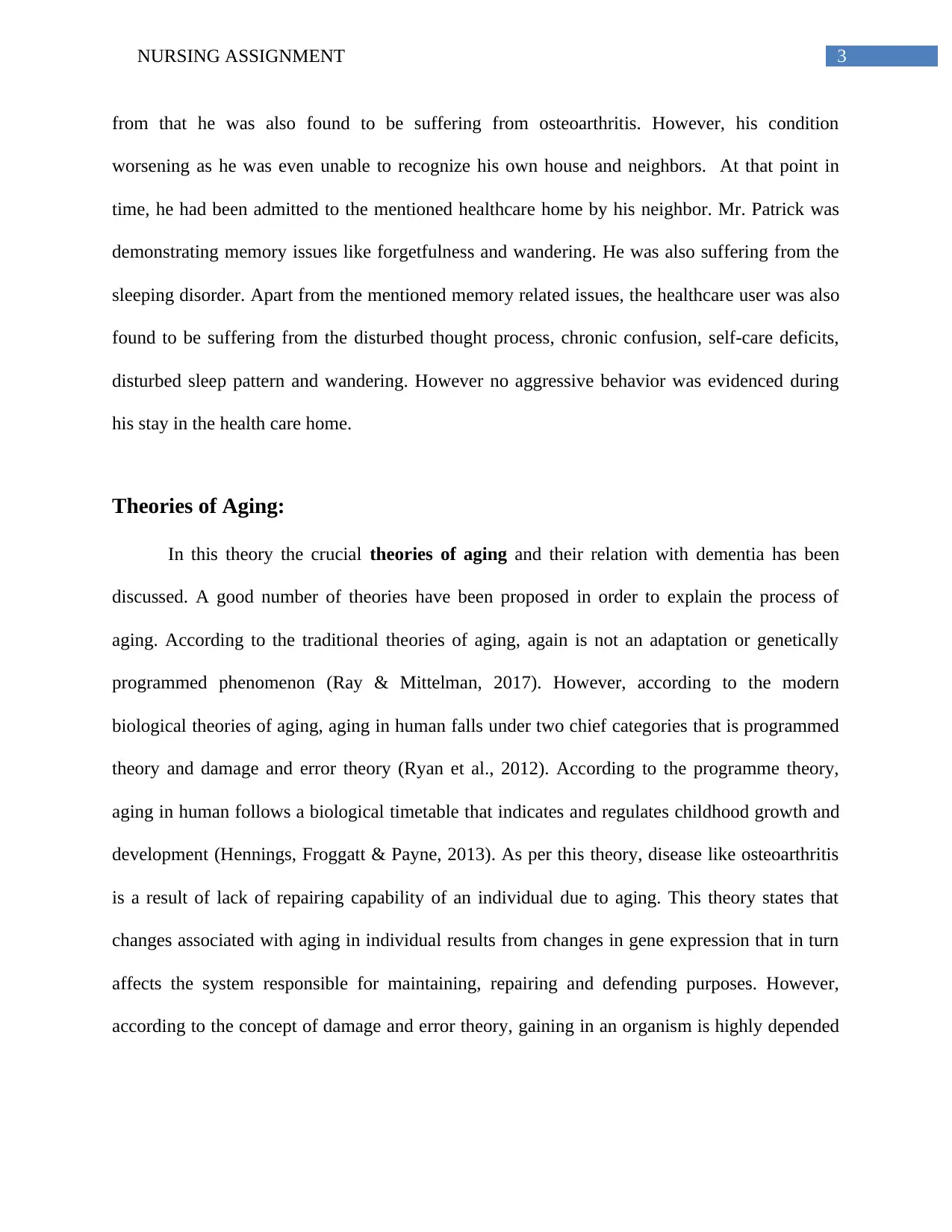
3NURSING ASSIGNMENT
from that he was also found to be suffering from osteoarthritis. However, his condition
worsening as he was even unable to recognize his own house and neighbors. At that point in
time, he had been admitted to the mentioned healthcare home by his neighbor. Mr. Patrick was
demonstrating memory issues like forgetfulness and wandering. He was also suffering from the
sleeping disorder. Apart from the mentioned memory related issues, the healthcare user was also
found to be suffering from the disturbed thought process, chronic confusion, self-care deficits,
disturbed sleep pattern and wandering. However no aggressive behavior was evidenced during
his stay in the health care home.
Theories of Aging:
In this theory the crucial theories of aging and their relation with dementia has been
discussed. A good number of theories have been proposed in order to explain the process of
aging. According to the traditional theories of aging, again is not an adaptation or genetically
programmed phenomenon (Ray & Mittelman, 2017). However, according to the modern
biological theories of aging, aging in human falls under two chief categories that is programmed
theory and damage and error theory (Ryan et al., 2012). According to the programme theory,
aging in human follows a biological timetable that indicates and regulates childhood growth and
development (Hennings, Froggatt & Payne, 2013). As per this theory, disease like osteoarthritis
is a result of lack of repairing capability of an individual due to aging. This theory states that
changes associated with aging in individual results from changes in gene expression that in turn
affects the system responsible for maintaining, repairing and defending purposes. However,
according to the concept of damage and error theory, gaining in an organism is highly depended
from that he was also found to be suffering from osteoarthritis. However, his condition
worsening as he was even unable to recognize his own house and neighbors. At that point in
time, he had been admitted to the mentioned healthcare home by his neighbor. Mr. Patrick was
demonstrating memory issues like forgetfulness and wandering. He was also suffering from the
sleeping disorder. Apart from the mentioned memory related issues, the healthcare user was also
found to be suffering from the disturbed thought process, chronic confusion, self-care deficits,
disturbed sleep pattern and wandering. However no aggressive behavior was evidenced during
his stay in the health care home.
Theories of Aging:
In this theory the crucial theories of aging and their relation with dementia has been
discussed. A good number of theories have been proposed in order to explain the process of
aging. According to the traditional theories of aging, again is not an adaptation or genetically
programmed phenomenon (Ray & Mittelman, 2017). However, according to the modern
biological theories of aging, aging in human falls under two chief categories that is programmed
theory and damage and error theory (Ryan et al., 2012). According to the programme theory,
aging in human follows a biological timetable that indicates and regulates childhood growth and
development (Hennings, Froggatt & Payne, 2013). As per this theory, disease like osteoarthritis
is a result of lack of repairing capability of an individual due to aging. This theory states that
changes associated with aging in individual results from changes in gene expression that in turn
affects the system responsible for maintaining, repairing and defending purposes. However,
according to the concept of damage and error theory, gaining in an organism is highly depended
Paraphrase This Document
Need a fresh take? Get an instant paraphrase of this document with our AI Paraphraser
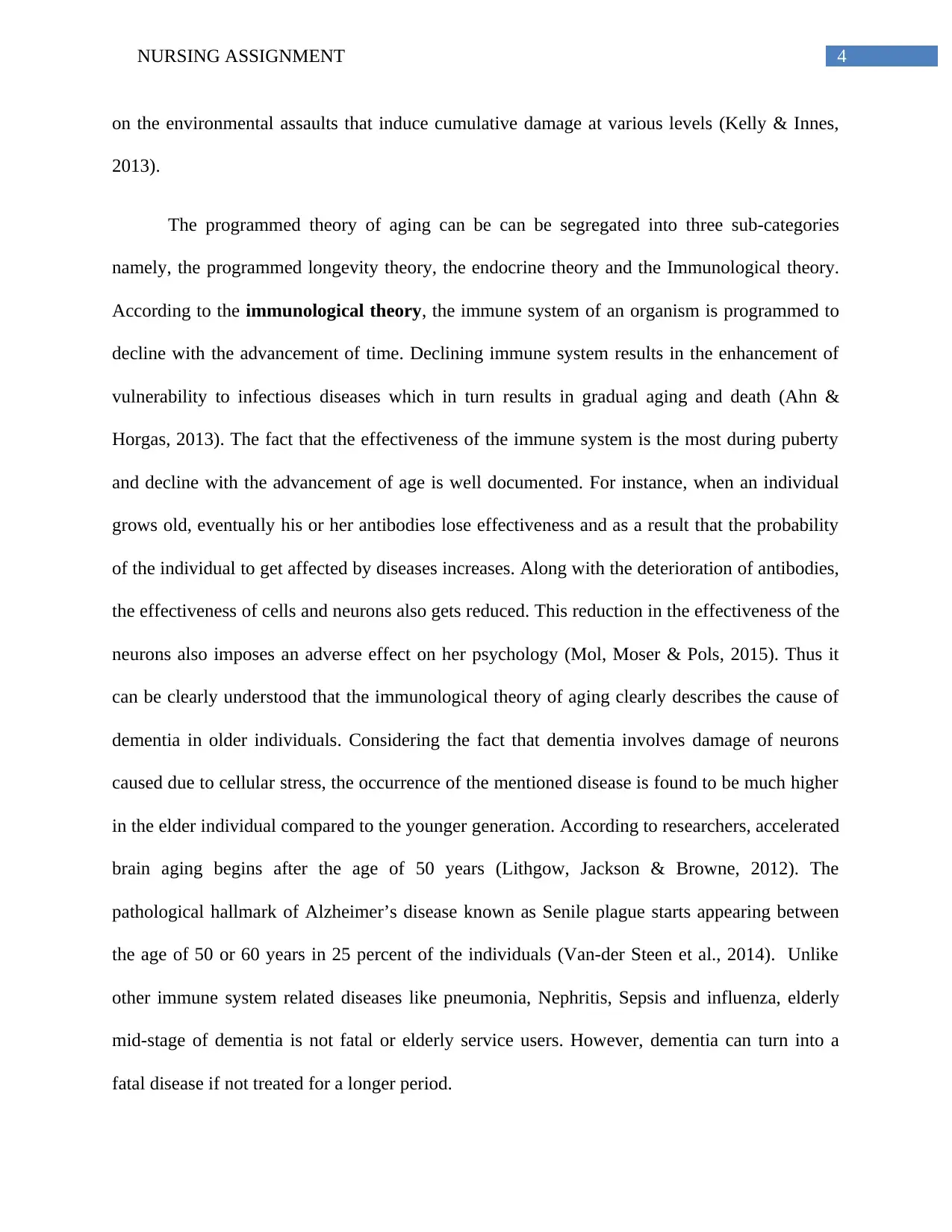
4NURSING ASSIGNMENT
on the environmental assaults that induce cumulative damage at various levels (Kelly & Innes,
2013).
The programmed theory of aging can be can be segregated into three sub-categories
namely, the programmed longevity theory, the endocrine theory and the Immunological theory.
According to the immunological theory, the immune system of an organism is programmed to
decline with the advancement of time. Declining immune system results in the enhancement of
vulnerability to infectious diseases which in turn results in gradual aging and death (Ahn &
Horgas, 2013). The fact that the effectiveness of the immune system is the most during puberty
and decline with the advancement of age is well documented. For instance, when an individual
grows old, eventually his or her antibodies lose effectiveness and as a result that the probability
of the individual to get affected by diseases increases. Along with the deterioration of antibodies,
the effectiveness of cells and neurons also gets reduced. This reduction in the effectiveness of the
neurons also imposes an adverse effect on her psychology (Mol, Moser & Pols, 2015). Thus it
can be clearly understood that the immunological theory of aging clearly describes the cause of
dementia in older individuals. Considering the fact that dementia involves damage of neurons
caused due to cellular stress, the occurrence of the mentioned disease is found to be much higher
in the elder individual compared to the younger generation. According to researchers, accelerated
brain aging begins after the age of 50 years (Lithgow, Jackson & Browne, 2012). The
pathological hallmark of Alzheimer’s disease known as Senile plague starts appearing between
the age of 50 or 60 years in 25 percent of the individuals (Van-der Steen et al., 2014). Unlike
other immune system related diseases like pneumonia, Nephritis, Sepsis and influenza, elderly
mid-stage of dementia is not fatal or elderly service users. However, dementia can turn into a
fatal disease if not treated for a longer period.
on the environmental assaults that induce cumulative damage at various levels (Kelly & Innes,
2013).
The programmed theory of aging can be can be segregated into three sub-categories
namely, the programmed longevity theory, the endocrine theory and the Immunological theory.
According to the immunological theory, the immune system of an organism is programmed to
decline with the advancement of time. Declining immune system results in the enhancement of
vulnerability to infectious diseases which in turn results in gradual aging and death (Ahn &
Horgas, 2013). The fact that the effectiveness of the immune system is the most during puberty
and decline with the advancement of age is well documented. For instance, when an individual
grows old, eventually his or her antibodies lose effectiveness and as a result that the probability
of the individual to get affected by diseases increases. Along with the deterioration of antibodies,
the effectiveness of cells and neurons also gets reduced. This reduction in the effectiveness of the
neurons also imposes an adverse effect on her psychology (Mol, Moser & Pols, 2015). Thus it
can be clearly understood that the immunological theory of aging clearly describes the cause of
dementia in older individuals. Considering the fact that dementia involves damage of neurons
caused due to cellular stress, the occurrence of the mentioned disease is found to be much higher
in the elder individual compared to the younger generation. According to researchers, accelerated
brain aging begins after the age of 50 years (Lithgow, Jackson & Browne, 2012). The
pathological hallmark of Alzheimer’s disease known as Senile plague starts appearing between
the age of 50 or 60 years in 25 percent of the individuals (Van-der Steen et al., 2014). Unlike
other immune system related diseases like pneumonia, Nephritis, Sepsis and influenza, elderly
mid-stage of dementia is not fatal or elderly service users. However, dementia can turn into a
fatal disease if not treated for a longer period.
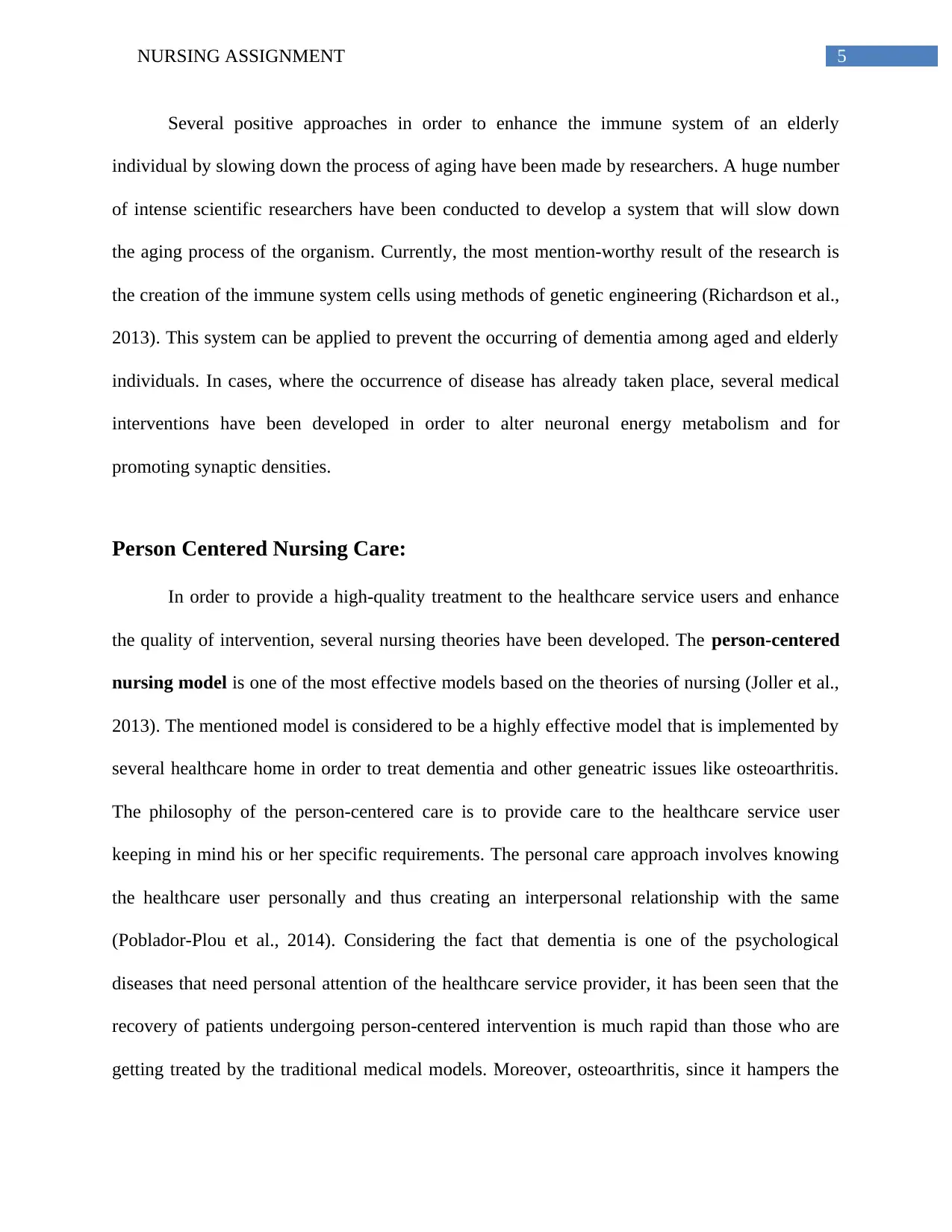
5NURSING ASSIGNMENT
Several positive approaches in order to enhance the immune system of an elderly
individual by slowing down the process of aging have been made by researchers. A huge number
of intense scientific researchers have been conducted to develop a system that will slow down
the aging process of the organism. Currently, the most mention-worthy result of the research is
the creation of the immune system cells using methods of genetic engineering (Richardson et al.,
2013). This system can be applied to prevent the occurring of dementia among aged and elderly
individuals. In cases, where the occurrence of disease has already taken place, several medical
interventions have been developed in order to alter neuronal energy metabolism and for
promoting synaptic densities.
Person Centered Nursing Care:
In order to provide a high-quality treatment to the healthcare service users and enhance
the quality of intervention, several nursing theories have been developed. The person-centered
nursing model is one of the most effective models based on the theories of nursing (Joller et al.,
2013). The mentioned model is considered to be a highly effective model that is implemented by
several healthcare home in order to treat dementia and other geneatric issues like osteoarthritis.
The philosophy of the person-centered care is to provide care to the healthcare service user
keeping in mind his or her specific requirements. The personal care approach involves knowing
the healthcare user personally and thus creating an interpersonal relationship with the same
(Poblador-Plou et al., 2014). Considering the fact that dementia is one of the psychological
diseases that need personal attention of the healthcare service provider, it has been seen that the
recovery of patients undergoing person-centered intervention is much rapid than those who are
getting treated by the traditional medical models. Moreover, osteoarthritis, since it hampers the
Several positive approaches in order to enhance the immune system of an elderly
individual by slowing down the process of aging have been made by researchers. A huge number
of intense scientific researchers have been conducted to develop a system that will slow down
the aging process of the organism. Currently, the most mention-worthy result of the research is
the creation of the immune system cells using methods of genetic engineering (Richardson et al.,
2013). This system can be applied to prevent the occurring of dementia among aged and elderly
individuals. In cases, where the occurrence of disease has already taken place, several medical
interventions have been developed in order to alter neuronal energy metabolism and for
promoting synaptic densities.
Person Centered Nursing Care:
In order to provide a high-quality treatment to the healthcare service users and enhance
the quality of intervention, several nursing theories have been developed. The person-centered
nursing model is one of the most effective models based on the theories of nursing (Joller et al.,
2013). The mentioned model is considered to be a highly effective model that is implemented by
several healthcare home in order to treat dementia and other geneatric issues like osteoarthritis.
The philosophy of the person-centered care is to provide care to the healthcare service user
keeping in mind his or her specific requirements. The personal care approach involves knowing
the healthcare user personally and thus creating an interpersonal relationship with the same
(Poblador-Plou et al., 2014). Considering the fact that dementia is one of the psychological
diseases that need personal attention of the healthcare service provider, it has been seen that the
recovery of patients undergoing person-centered intervention is much rapid than those who are
getting treated by the traditional medical models. Moreover, osteoarthritis, since it hampers the
⊘ This is a preview!⊘
Do you want full access?
Subscribe today to unlock all pages.

Trusted by 1+ million students worldwide
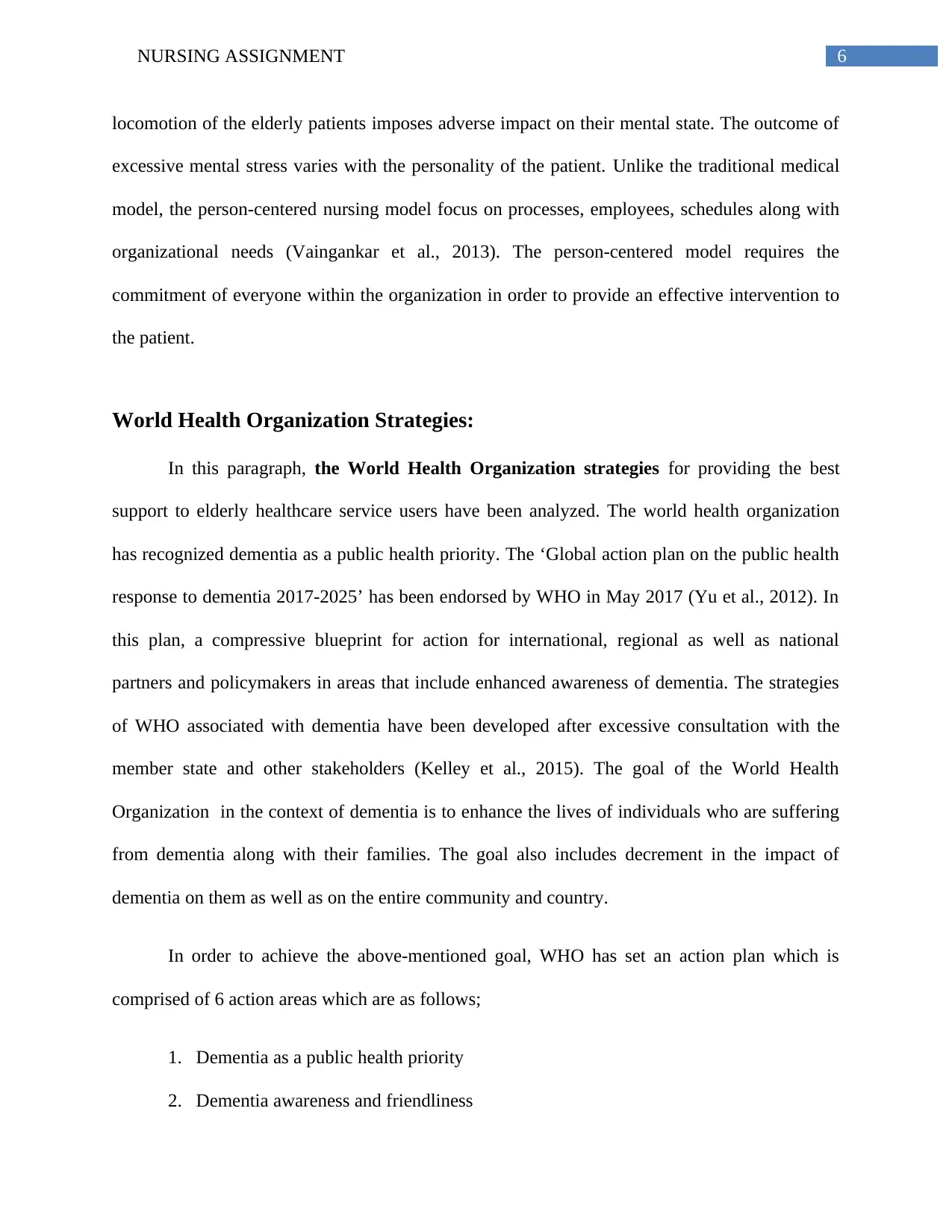
6NURSING ASSIGNMENT
locomotion of the elderly patients imposes adverse impact on their mental state. The outcome of
excessive mental stress varies with the personality of the patient. Unlike the traditional medical
model, the person-centered nursing model focus on processes, employees, schedules along with
organizational needs (Vaingankar et al., 2013). The person-centered model requires the
commitment of everyone within the organization in order to provide an effective intervention to
the patient.
World Health Organization Strategies:
In this paragraph, the World Health Organization strategies for providing the best
support to elderly healthcare service users have been analyzed. The world health organization
has recognized dementia as a public health priority. The ‘Global action plan on the public health
response to dementia 2017-2025’ has been endorsed by WHO in May 2017 (Yu et al., 2012). In
this plan, a compressive blueprint for action for international, regional as well as national
partners and policymakers in areas that include enhanced awareness of dementia. The strategies
of WHO associated with dementia have been developed after excessive consultation with the
member state and other stakeholders (Kelley et al., 2015). The goal of the World Health
Organization in the context of dementia is to enhance the lives of individuals who are suffering
from dementia along with their families. The goal also includes decrement in the impact of
dementia on them as well as on the entire community and country.
In order to achieve the above-mentioned goal, WHO has set an action plan which is
comprised of 6 action areas which are as follows;
1. Dementia as a public health priority
2. Dementia awareness and friendliness
locomotion of the elderly patients imposes adverse impact on their mental state. The outcome of
excessive mental stress varies with the personality of the patient. Unlike the traditional medical
model, the person-centered nursing model focus on processes, employees, schedules along with
organizational needs (Vaingankar et al., 2013). The person-centered model requires the
commitment of everyone within the organization in order to provide an effective intervention to
the patient.
World Health Organization Strategies:
In this paragraph, the World Health Organization strategies for providing the best
support to elderly healthcare service users have been analyzed. The world health organization
has recognized dementia as a public health priority. The ‘Global action plan on the public health
response to dementia 2017-2025’ has been endorsed by WHO in May 2017 (Yu et al., 2012). In
this plan, a compressive blueprint for action for international, regional as well as national
partners and policymakers in areas that include enhanced awareness of dementia. The strategies
of WHO associated with dementia have been developed after excessive consultation with the
member state and other stakeholders (Kelley et al., 2015). The goal of the World Health
Organization in the context of dementia is to enhance the lives of individuals who are suffering
from dementia along with their families. The goal also includes decrement in the impact of
dementia on them as well as on the entire community and country.
In order to achieve the above-mentioned goal, WHO has set an action plan which is
comprised of 6 action areas which are as follows;
1. Dementia as a public health priority
2. Dementia awareness and friendliness
Paraphrase This Document
Need a fresh take? Get an instant paraphrase of this document with our AI Paraphraser
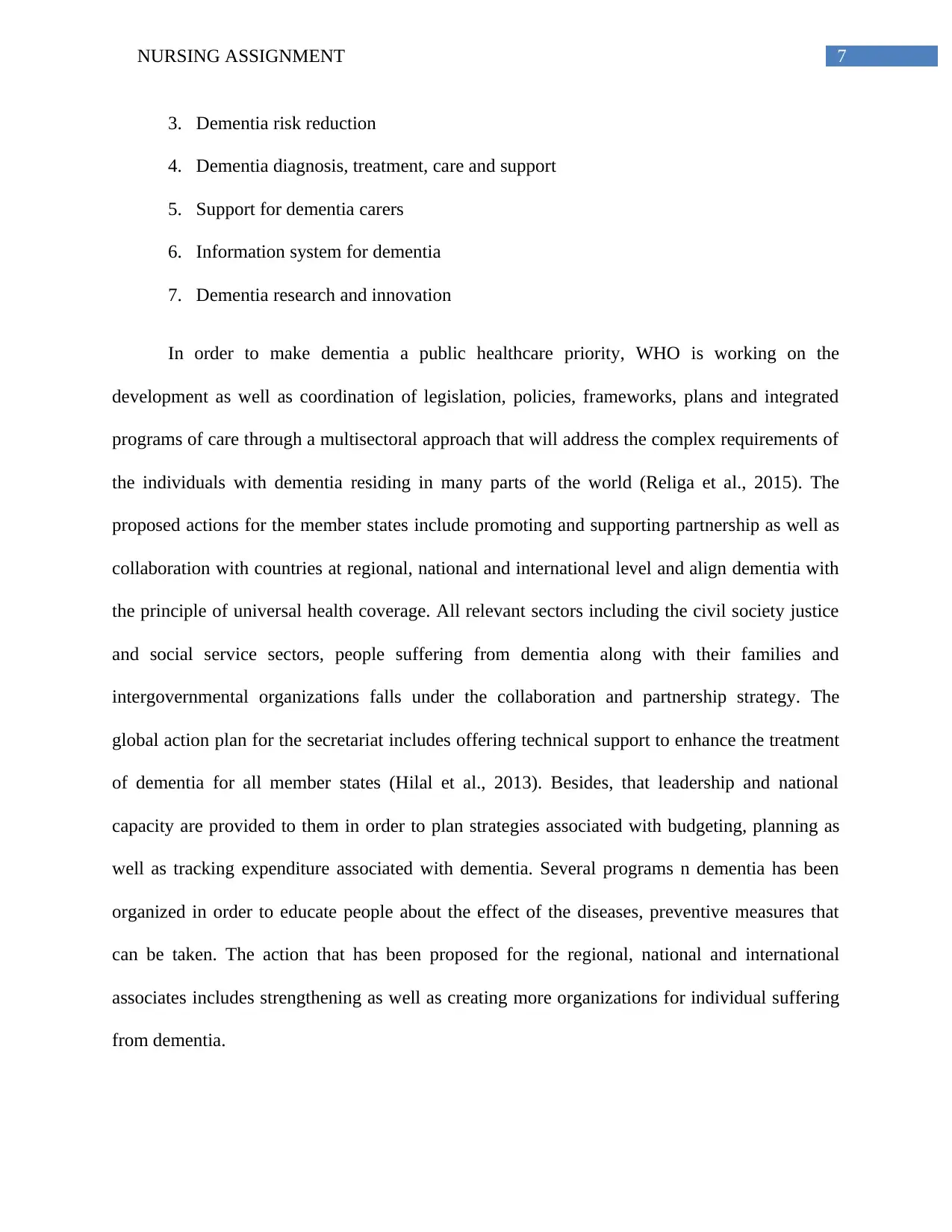
7NURSING ASSIGNMENT
3. Dementia risk reduction
4. Dementia diagnosis, treatment, care and support
5. Support for dementia carers
6. Information system for dementia
7. Dementia research and innovation
In order to make dementia a public healthcare priority, WHO is working on the
development as well as coordination of legislation, policies, frameworks, plans and integrated
programs of care through a multisectoral approach that will address the complex requirements of
the individuals with dementia residing in many parts of the world (Religa et al., 2015). The
proposed actions for the member states include promoting and supporting partnership as well as
collaboration with countries at regional, national and international level and align dementia with
the principle of universal health coverage. All relevant sectors including the civil society justice
and social service sectors, people suffering from dementia along with their families and
intergovernmental organizations falls under the collaboration and partnership strategy. The
global action plan for the secretariat includes offering technical support to enhance the treatment
of dementia for all member states (Hilal et al., 2013). Besides, that leadership and national
capacity are provided to them in order to plan strategies associated with budgeting, planning as
well as tracking expenditure associated with dementia. Several programs n dementia has been
organized in order to educate people about the effect of the diseases, preventive measures that
can be taken. The action that has been proposed for the regional, national and international
associates includes strengthening as well as creating more organizations for individual suffering
from dementia.
3. Dementia risk reduction
4. Dementia diagnosis, treatment, care and support
5. Support for dementia carers
6. Information system for dementia
7. Dementia research and innovation
In order to make dementia a public healthcare priority, WHO is working on the
development as well as coordination of legislation, policies, frameworks, plans and integrated
programs of care through a multisectoral approach that will address the complex requirements of
the individuals with dementia residing in many parts of the world (Religa et al., 2015). The
proposed actions for the member states include promoting and supporting partnership as well as
collaboration with countries at regional, national and international level and align dementia with
the principle of universal health coverage. All relevant sectors including the civil society justice
and social service sectors, people suffering from dementia along with their families and
intergovernmental organizations falls under the collaboration and partnership strategy. The
global action plan for the secretariat includes offering technical support to enhance the treatment
of dementia for all member states (Hilal et al., 2013). Besides, that leadership and national
capacity are provided to them in order to plan strategies associated with budgeting, planning as
well as tracking expenditure associated with dementia. Several programs n dementia has been
organized in order to educate people about the effect of the diseases, preventive measures that
can be taken. The action that has been proposed for the regional, national and international
associates includes strengthening as well as creating more organizations for individual suffering
from dementia.
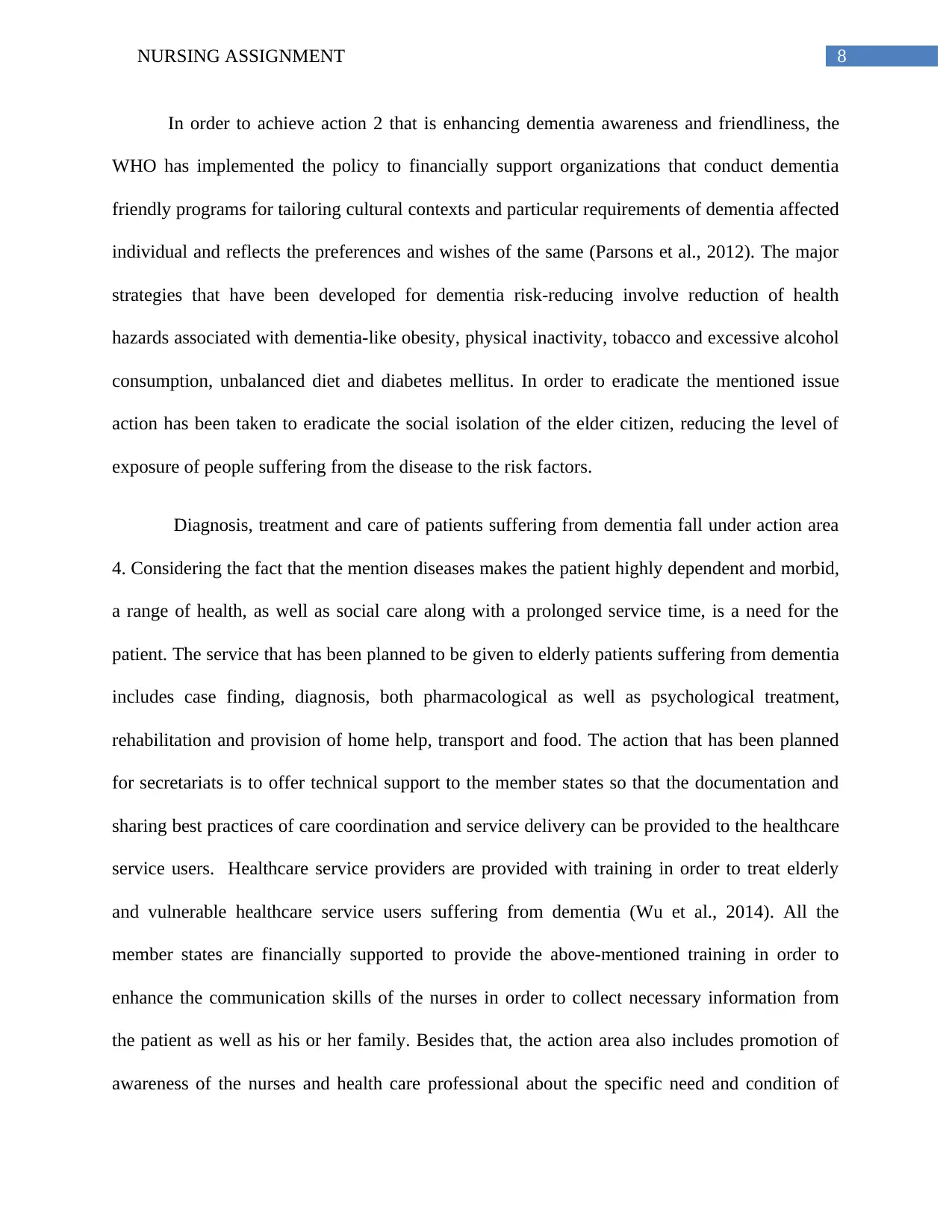
8NURSING ASSIGNMENT
In order to achieve action 2 that is enhancing dementia awareness and friendliness, the
WHO has implemented the policy to financially support organizations that conduct dementia
friendly programs for tailoring cultural contexts and particular requirements of dementia affected
individual and reflects the preferences and wishes of the same (Parsons et al., 2012). The major
strategies that have been developed for dementia risk-reducing involve reduction of health
hazards associated with dementia-like obesity, physical inactivity, tobacco and excessive alcohol
consumption, unbalanced diet and diabetes mellitus. In order to eradicate the mentioned issue
action has been taken to eradicate the social isolation of the elder citizen, reducing the level of
exposure of people suffering from the disease to the risk factors.
Diagnosis, treatment and care of patients suffering from dementia fall under action area
4. Considering the fact that the mention diseases makes the patient highly dependent and morbid,
a range of health, as well as social care along with a prolonged service time, is a need for the
patient. The service that has been planned to be given to elderly patients suffering from dementia
includes case finding, diagnosis, both pharmacological as well as psychological treatment,
rehabilitation and provision of home help, transport and food. The action that has been planned
for secretariats is to offer technical support to the member states so that the documentation and
sharing best practices of care coordination and service delivery can be provided to the healthcare
service users. Healthcare service providers are provided with training in order to treat elderly
and vulnerable healthcare service users suffering from dementia (Wu et al., 2014). All the
member states are financially supported to provide the above-mentioned training in order to
enhance the communication skills of the nurses in order to collect necessary information from
the patient as well as his or her family. Besides that, the action area also includes promotion of
awareness of the nurses and health care professional about the specific need and condition of
In order to achieve action 2 that is enhancing dementia awareness and friendliness, the
WHO has implemented the policy to financially support organizations that conduct dementia
friendly programs for tailoring cultural contexts and particular requirements of dementia affected
individual and reflects the preferences and wishes of the same (Parsons et al., 2012). The major
strategies that have been developed for dementia risk-reducing involve reduction of health
hazards associated with dementia-like obesity, physical inactivity, tobacco and excessive alcohol
consumption, unbalanced diet and diabetes mellitus. In order to eradicate the mentioned issue
action has been taken to eradicate the social isolation of the elder citizen, reducing the level of
exposure of people suffering from the disease to the risk factors.
Diagnosis, treatment and care of patients suffering from dementia fall under action area
4. Considering the fact that the mention diseases makes the patient highly dependent and morbid,
a range of health, as well as social care along with a prolonged service time, is a need for the
patient. The service that has been planned to be given to elderly patients suffering from dementia
includes case finding, diagnosis, both pharmacological as well as psychological treatment,
rehabilitation and provision of home help, transport and food. The action that has been planned
for secretariats is to offer technical support to the member states so that the documentation and
sharing best practices of care coordination and service delivery can be provided to the healthcare
service users. Healthcare service providers are provided with training in order to treat elderly
and vulnerable healthcare service users suffering from dementia (Wu et al., 2014). All the
member states are financially supported to provide the above-mentioned training in order to
enhance the communication skills of the nurses in order to collect necessary information from
the patient as well as his or her family. Besides that, the action area also includes promotion of
awareness of the nurses and health care professional about the specific need and condition of
⊘ This is a preview!⊘
Do you want full access?
Subscribe today to unlock all pages.

Trusted by 1+ million students worldwide
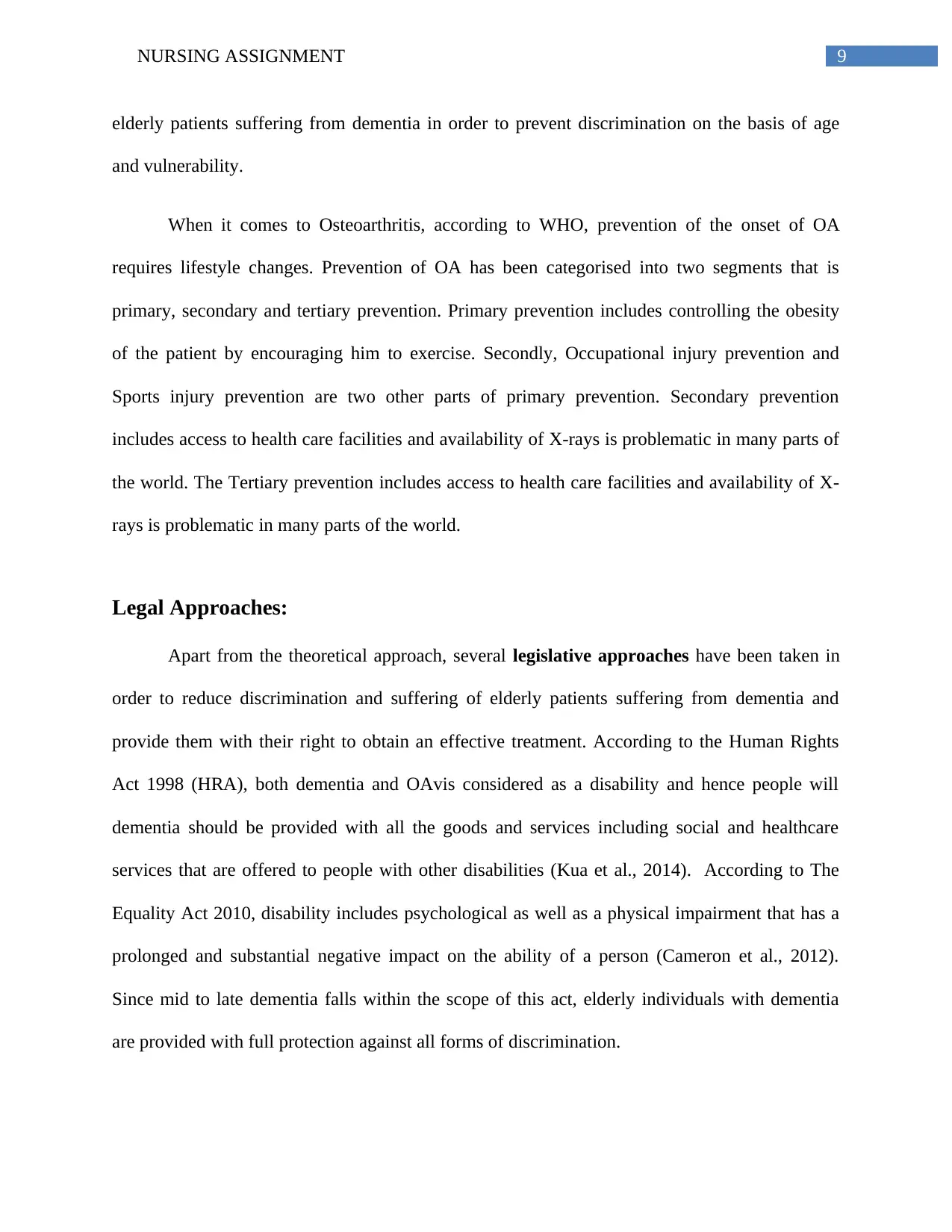
9NURSING ASSIGNMENT
elderly patients suffering from dementia in order to prevent discrimination on the basis of age
and vulnerability.
When it comes to Osteoarthritis, according to WHO, prevention of the onset of OA
requires lifestyle changes. Prevention of OA has been categorised into two segments that is
primary, secondary and tertiary prevention. Primary prevention includes controlling the obesity
of the patient by encouraging him to exercise. Secondly, Occupational injury prevention and
Sports injury prevention are two other parts of primary prevention. Secondary prevention
includes access to health care facilities and availability of X-rays is problematic in many parts of
the world. The Tertiary prevention includes access to health care facilities and availability of X-
rays is problematic in many parts of the world.
Legal Approaches:
Apart from the theoretical approach, several legislative approaches have been taken in
order to reduce discrimination and suffering of elderly patients suffering from dementia and
provide them with their right to obtain an effective treatment. According to the Human Rights
Act 1998 (HRA), both dementia and OAvis considered as a disability and hence people will
dementia should be provided with all the goods and services including social and healthcare
services that are offered to people with other disabilities (Kua et al., 2014). According to The
Equality Act 2010, disability includes psychological as well as a physical impairment that has a
prolonged and substantial negative impact on the ability of a person (Cameron et al., 2012).
Since mid to late dementia falls within the scope of this act, elderly individuals with dementia
are provided with full protection against all forms of discrimination.
elderly patients suffering from dementia in order to prevent discrimination on the basis of age
and vulnerability.
When it comes to Osteoarthritis, according to WHO, prevention of the onset of OA
requires lifestyle changes. Prevention of OA has been categorised into two segments that is
primary, secondary and tertiary prevention. Primary prevention includes controlling the obesity
of the patient by encouraging him to exercise. Secondly, Occupational injury prevention and
Sports injury prevention are two other parts of primary prevention. Secondary prevention
includes access to health care facilities and availability of X-rays is problematic in many parts of
the world. The Tertiary prevention includes access to health care facilities and availability of X-
rays is problematic in many parts of the world.
Legal Approaches:
Apart from the theoretical approach, several legislative approaches have been taken in
order to reduce discrimination and suffering of elderly patients suffering from dementia and
provide them with their right to obtain an effective treatment. According to the Human Rights
Act 1998 (HRA), both dementia and OAvis considered as a disability and hence people will
dementia should be provided with all the goods and services including social and healthcare
services that are offered to people with other disabilities (Kua et al., 2014). According to The
Equality Act 2010, disability includes psychological as well as a physical impairment that has a
prolonged and substantial negative impact on the ability of a person (Cameron et al., 2012).
Since mid to late dementia falls within the scope of this act, elderly individuals with dementia
are provided with full protection against all forms of discrimination.
Paraphrase This Document
Need a fresh take? Get an instant paraphrase of this document with our AI Paraphraser
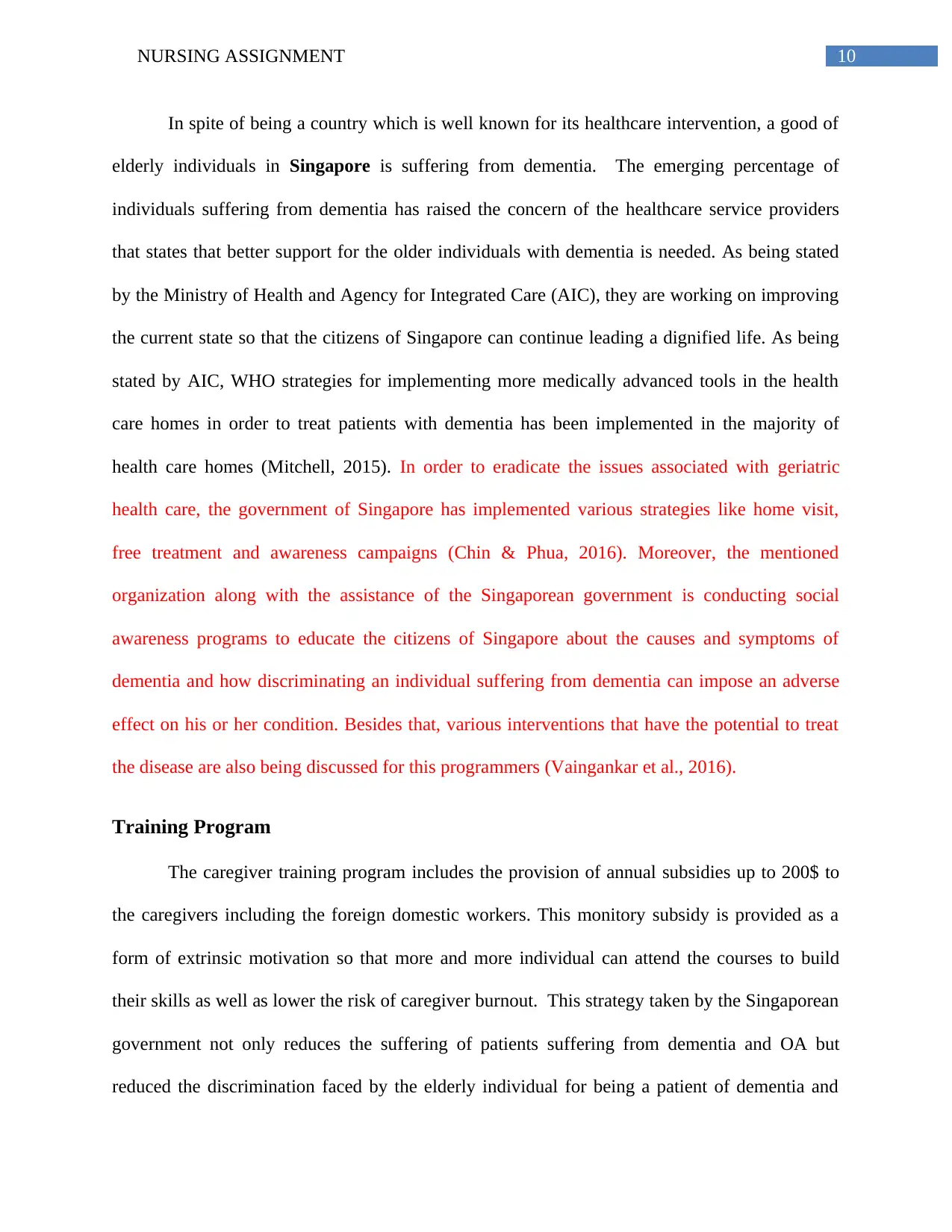
10NURSING ASSIGNMENT
In spite of being a country which is well known for its healthcare intervention, a good of
elderly individuals in Singapore is suffering from dementia. The emerging percentage of
individuals suffering from dementia has raised the concern of the healthcare service providers
that states that better support for the older individuals with dementia is needed. As being stated
by the Ministry of Health and Agency for Integrated Care (AIC), they are working on improving
the current state so that the citizens of Singapore can continue leading a dignified life. As being
stated by AIC, WHO strategies for implementing more medically advanced tools in the health
care homes in order to treat patients with dementia has been implemented in the majority of
health care homes (Mitchell, 2015). In order to eradicate the issues associated with geriatric
health care, the government of Singapore has implemented various strategies like home visit,
free treatment and awareness campaigns (Chin & Phua, 2016). Moreover, the mentioned
organization along with the assistance of the Singaporean government is conducting social
awareness programs to educate the citizens of Singapore about the causes and symptoms of
dementia and how discriminating an individual suffering from dementia can impose an adverse
effect on his or her condition. Besides that, various interventions that have the potential to treat
the disease are also being discussed for this programmers (Vaingankar et al., 2016).
Training Program
The caregiver training program includes the provision of annual subsidies up to 200$ to
the caregivers including the foreign domestic workers. This monitory subsidy is provided as a
form of extrinsic motivation so that more and more individual can attend the courses to build
their skills as well as lower the risk of caregiver burnout. This strategy taken by the Singaporean
government not only reduces the suffering of patients suffering from dementia and OA but
reduced the discrimination faced by the elderly individual for being a patient of dementia and
In spite of being a country which is well known for its healthcare intervention, a good of
elderly individuals in Singapore is suffering from dementia. The emerging percentage of
individuals suffering from dementia has raised the concern of the healthcare service providers
that states that better support for the older individuals with dementia is needed. As being stated
by the Ministry of Health and Agency for Integrated Care (AIC), they are working on improving
the current state so that the citizens of Singapore can continue leading a dignified life. As being
stated by AIC, WHO strategies for implementing more medically advanced tools in the health
care homes in order to treat patients with dementia has been implemented in the majority of
health care homes (Mitchell, 2015). In order to eradicate the issues associated with geriatric
health care, the government of Singapore has implemented various strategies like home visit,
free treatment and awareness campaigns (Chin & Phua, 2016). Moreover, the mentioned
organization along with the assistance of the Singaporean government is conducting social
awareness programs to educate the citizens of Singapore about the causes and symptoms of
dementia and how discriminating an individual suffering from dementia can impose an adverse
effect on his or her condition. Besides that, various interventions that have the potential to treat
the disease are also being discussed for this programmers (Vaingankar et al., 2016).
Training Program
The caregiver training program includes the provision of annual subsidies up to 200$ to
the caregivers including the foreign domestic workers. This monitory subsidy is provided as a
form of extrinsic motivation so that more and more individual can attend the courses to build
their skills as well as lower the risk of caregiver burnout. This strategy taken by the Singaporean
government not only reduces the suffering of patients suffering from dementia and OA but
reduced the discrimination faced by the elderly individual for being a patient of dementia and
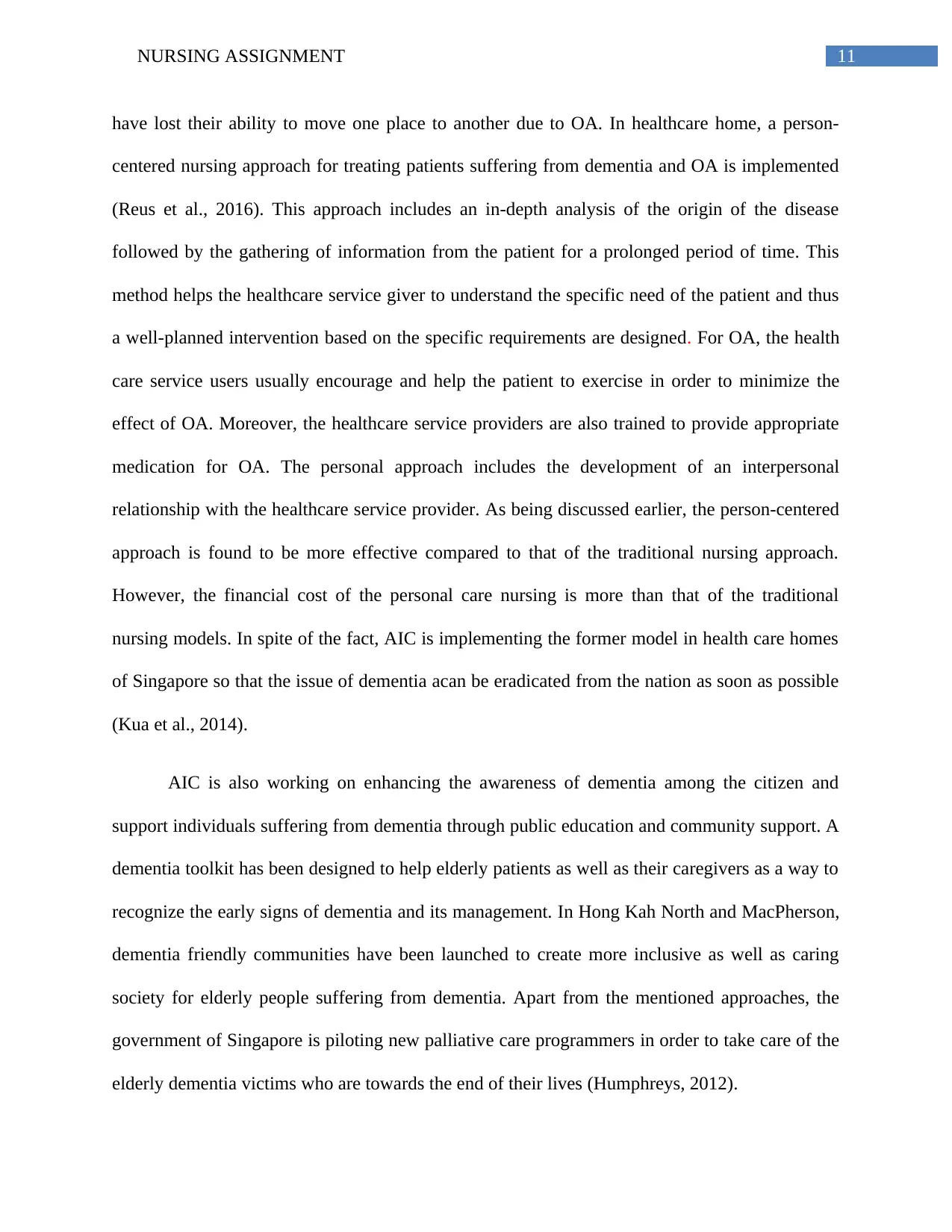
11NURSING ASSIGNMENT
have lost their ability to move one place to another due to OA. In healthcare home, a person-
centered nursing approach for treating patients suffering from dementia and OA is implemented
(Reus et al., 2016). This approach includes an in-depth analysis of the origin of the disease
followed by the gathering of information from the patient for a prolonged period of time. This
method helps the healthcare service giver to understand the specific need of the patient and thus
a well-planned intervention based on the specific requirements are designed. For OA, the health
care service users usually encourage and help the patient to exercise in order to minimize the
effect of OA. Moreover, the healthcare service providers are also trained to provide appropriate
medication for OA. The personal approach includes the development of an interpersonal
relationship with the healthcare service provider. As being discussed earlier, the person-centered
approach is found to be more effective compared to that of the traditional nursing approach.
However, the financial cost of the personal care nursing is more than that of the traditional
nursing models. In spite of the fact, AIC is implementing the former model in health care homes
of Singapore so that the issue of dementia acan be eradicated from the nation as soon as possible
(Kua et al., 2014).
AIC is also working on enhancing the awareness of dementia among the citizen and
support individuals suffering from dementia through public education and community support. A
dementia toolkit has been designed to help elderly patients as well as their caregivers as a way to
recognize the early signs of dementia and its management. In Hong Kah North and MacPherson,
dementia friendly communities have been launched to create more inclusive as well as caring
society for elderly people suffering from dementia. Apart from the mentioned approaches, the
government of Singapore is piloting new palliative care programmers in order to take care of the
elderly dementia victims who are towards the end of their lives (Humphreys, 2012).
have lost their ability to move one place to another due to OA. In healthcare home, a person-
centered nursing approach for treating patients suffering from dementia and OA is implemented
(Reus et al., 2016). This approach includes an in-depth analysis of the origin of the disease
followed by the gathering of information from the patient for a prolonged period of time. This
method helps the healthcare service giver to understand the specific need of the patient and thus
a well-planned intervention based on the specific requirements are designed. For OA, the health
care service users usually encourage and help the patient to exercise in order to minimize the
effect of OA. Moreover, the healthcare service providers are also trained to provide appropriate
medication for OA. The personal approach includes the development of an interpersonal
relationship with the healthcare service provider. As being discussed earlier, the person-centered
approach is found to be more effective compared to that of the traditional nursing approach.
However, the financial cost of the personal care nursing is more than that of the traditional
nursing models. In spite of the fact, AIC is implementing the former model in health care homes
of Singapore so that the issue of dementia acan be eradicated from the nation as soon as possible
(Kua et al., 2014).
AIC is also working on enhancing the awareness of dementia among the citizen and
support individuals suffering from dementia through public education and community support. A
dementia toolkit has been designed to help elderly patients as well as their caregivers as a way to
recognize the early signs of dementia and its management. In Hong Kah North and MacPherson,
dementia friendly communities have been launched to create more inclusive as well as caring
society for elderly people suffering from dementia. Apart from the mentioned approaches, the
government of Singapore is piloting new palliative care programmers in order to take care of the
elderly dementia victims who are towards the end of their lives (Humphreys, 2012).
⊘ This is a preview!⊘
Do you want full access?
Subscribe today to unlock all pages.

Trusted by 1+ million students worldwide
1 out of 21
Related Documents
Your All-in-One AI-Powered Toolkit for Academic Success.
+13062052269
info@desklib.com
Available 24*7 on WhatsApp / Email
![[object Object]](/_next/static/media/star-bottom.7253800d.svg)
Unlock your academic potential
Copyright © 2020–2025 A2Z Services. All Rights Reserved. Developed and managed by ZUCOL.




